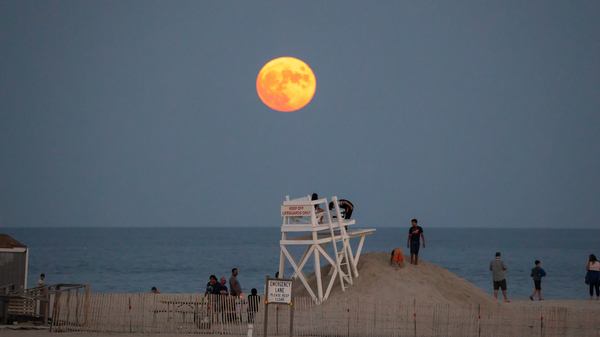Best Ways to See the Super Strawberry Moon in June
Everyone can see the Super Strawberry Moon in June! The Strawberry Moon will be close to Earth, making it a Supermoon. Here are some tips on how to see it.

Look up for a the Super Strawberry Moon in June! The Full Moon will be close to Earth, making it a Supermoon. The Strawberry Moon over Long Beach, New York, in June 2021.
©iStockphoto.com/Scott Heaney
When Is the Super Strawberry Moon?
The Full Moon on June 14, 2022 is known as the Strawberry Moon, and because it is very near Earth in its orbit, it is also a Supermoon.
To be precise, the exact time of the Full Moon is 11:51 UTC. However, you might not be able to see it at that exact moment because the Moon’s phase are not defined by the Moon’s visibility from Earth but by its position in its orbit around Earth.
There will be another Supermoon in July: The Super Buck Moon on July 13, 2022.
Everyone Can See the Supermoon
All you need to know to see the Strawberry Super Moon are moonrise and moonset times for your location. Full Moons rise around sunset and set around sunrise.
A Super Full Moon can look up to 7% bigger than an average Full Moon, and it looks 14% bigger and 30% brighter than a Micromoon.
The Moon appears full in the days before and after the exact time of the Full Moon, so if the weather doesn’t play along on the day or you missed moonrise on June 14, you can still catch a spectacular sight on the next day.

You can see the near-Full Moon in the morning and evening a couple of days before and after the exact Full Moon time. A near-Full Moon seen from Copacabana in Rio de Janeiro, Brazil.
©iStockphoto.com/Brunomartinsimagens
Very Big Old Rock in the Sky
“Gazing up at a Full Moon is always a humbling experience,” says Graham Jones, timeanddate's resident astrophysicist.
“The area of the nearside of the Moon—the side facing us—is the same as the area of the US and Canada combined,” he says, and adds:
“It’s a view that hasn’t changed throughout human history. Even Tycho Crater, the youngest of the Moon’s most prominent craters, is over 100 million years old.”
Our Moon is made of rock and metal
Full Moon Close to the Horizon
Even ‘normal’ Full Moons look big and beautiful around this time:
- The Full Moon swoops low across the summer night sky in the Northern Hemisphere. This is because the path of the Moon is affected by the Earth’s axial tilt away from the Full Moon and toward the Sun.
- Watching the Full Moon at moonrise or moonset lets you view it close to the horizon. This tricks our brains into thinking it is much bigger than it actually is: the Moon Illusion.
Why is the Full Moon in the daytime?
Will It Be Cloudy?
Keep an eye on our weather reports for up-to-date predictions! A cloudy sky may cover the Moon, though a few clouds add drama to your viewing.

Your position and your surroundings can really make a Moon photo. A Full Moon rises behind the sails of the Sydney Opera House in Sydney, Australia.
©iStockphoto.com/kokkai
What Is a Supermoon?
A Supermoon is when a Full Moon takes place when the Moon is near its closest approach to Earth, known as perigee. At timeanddate, we define a Supermoon as a Full Moon that occurs when the center of the Moon is less than 360,000 kilometers (ca. 223,694 miles) from the center of Earth.
“The distance from Earth to the Moon at this month’s Full Moon is around 358,000 kilometers (222,000 miles),” says Graham Jones.
The Sun Makes It a Supermoon
The Moon can be near—or far away from—Earth during any Moon phase, but it is only at Full Moon or New Moon that it gets really close:
“It’s interesting to note that these super-close distances only occur at Full Moon or New Moon, when the Sun’s gravity comes into play. In contrast, according to timeanddate’s data, the closest the Moon gets to Earth this year at First or Third Quarter is about 370,000 kilometers (230,000 miles),“ explains Graham Jones.
Take Pictures
Follow our step-by-step guide on how to capture the Strawberry Super Moon. Set yourself up for success by knowing where to be, when to be there, and what to do when the Supermoon rises.